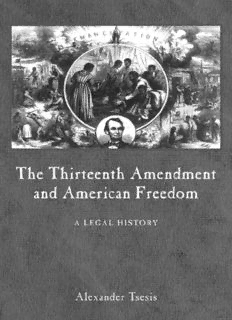
The Thirteenth Amendment and American Freedom: A Legal History (Constitutional Amendments) PDF
Preview The Thirteenth Amendment and American Freedom: A Legal History (Constitutional Amendments)
the thirteenth amendment and american freedom The Thirteenth Amendment and American Freedom a legal history Alexander Tsesis a new york university press New York and London new york university press New York and London www.nyupress.org © 2004by New York University All rights reserved Library of Congress Cataloging-in-Publication Data Tsesis, Alexander. The Thirteenth Amendment and American freedom : a legal history / Alexander Tsesis. p. cm. Includes bibliographical references and index. ISBN 0–8147–8276–0(cloth : alk. paper) 1. Slavery—Law and legislation—United States—History. 2. United States—Constitution—13th Amendment—History. I. Title. KF4545.S5T74 2004 342.7308'7—dc22 2004010882 New York University Press books are printed on acid-free paper, and their binding materials are chosen for strength and durability. Manufactured in the United States of America 10 9 8 7 6 5 4 3 2 1 For my parents, Vladimir and Marina Tsesis Contents Acknowledgments ix Preface 1 part i 1 Slavery and Its Social Penetration 11 A. Slavery and the Founding Generation 12 B. Slavery as a Cultural Institution 18 C. Centrality of Slavery in Sectional Conflicts 23 2 On the Road to Ratification 34 A. Emancipation by Statute and Proclamation 34 B. Congressional Debates on the Thirteenth Amendment’s Meaning 37 C. The Immediate Aftermath of Liberation 48 1. What Sort of Freedom? 48 2. Legal Protections 53 3 End of Radical Ideals and Judicial Response 59 A. Political Abandonment of Reconstruction 59 B. Supreme Court Abandonment of Reconstruction 61 1. Early Opinions 62 2. Relinquishment of Thirteenth Amendment Principles 67 C. A Ray of Hope: Jones v. Alfred H. Mayer 82 D. Summing Up 92 4 Summing Up and Looking Ahead 94 vii viii | Contents part ii 5 Theoretical Foundation 101 A. Abolition and Natural Rights 101 B. Thirteenth Amendment and Universal Liberty 104 6 Thirteenth Amendment and Constitutional Rights 112 A. Thirteenth and Fourteenth Amendment Freedoms 112 B. Source for Substantive Freedom 117 C. Commerce Clause and Thirteenth Amendment 131 7 Contemporary Settings 137 A. Confederate Symbols 137 1. National Symbolism 137 2. Peculiarities of Confederate Symbols 140 3. Revival of Confederate Symbolism 143 4. Federal Authority 147 B. Hate Crimes 149 C. Contemporary Instances of Peonage 154 Conclusion 161 Notes 163 Select Bibliography 201 Index 221 About the Author 229 Acknowledgments Contacts I made with friends and acquaintances during the writing of this book made for a delightful process. Their ideas elevated my understand- ing, and only time constraints and my shortcomings prevent a better in- tegration of their suggestions. I am deeply grateful for the generosity with which collocutors shared their precious time discussing a subject so im- portant to me and giving feedback at various stages of writing. Even before I put fingers to keyboard, several outstanding scholars helped with the project’s proposed organization. And even though I kept tinkering with the structure until the very end, the advice I received from them was critical. Most encouraging were the recommendations of David Brion Davis, Eric Foner, James M. McPherson, and David M. Oshinsky. Once the manuscript was complete, Andrew E. Taslitz’s multi-page cri- tique, which spoke volumes on how the Reconstruction altered the Con- stitution, was very helpful. G. Sidney Buchanan and William M. Wiecek aided me with their rich comprehension of legal history that came from decades of research into the Thirteenth Amendment. Both of them pro- vided tremendous insights on an earlier draft and raised my spirits with their support. Segments of the text profited from the excellent editing of Howard S. Erlanger and Richard Warner. I also owe gratitude to the anonymous readers whom the New York University Press solicited. At various points, Daniel Bordoni, Kenneth Obel, Shannon Verner, and Amy Wolff provided helpful stylistic remarks. Among the many others who offered invaluable advice were Richard Delgado, William E. Forbath, Bruce Goldstein, Emma Coleman Jordan, and Jonathan Lurie. Conversations with Robert J. Cottrol on aspects of slavery helped to put the United States experience into better perspective. The comments of Harold J. Krent, Stewart Macaulay, Sheldon H. Nah- mod, Mark D. Rosen, Richard J. Ross, Margaret G. Stewart, and Michael J. Zimmer, who participated in faculty workshops at the University of ix
Description: